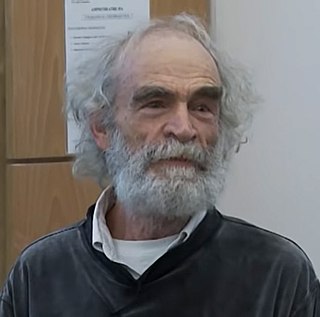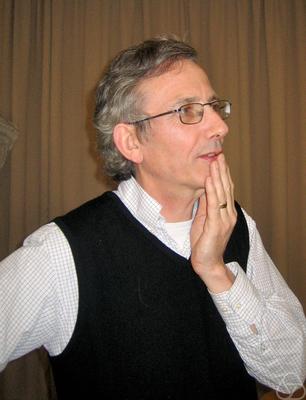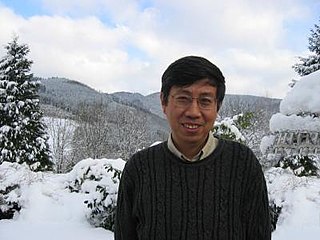
In algebraic and differential geometry, a Calabi–Yau manifold, also known as a Calabi–Yau space, is a particular type of manifold which has certain properties, such as Ricci flatness, yielding applications in theoretical physics. Particularly in superstring theory, the extra dimensions of spacetime are sometimes conjectured to take the form of a 6-dimensional Calabi–Yau manifold, which led to the idea of mirror symmetry. Their name was coined by Candelas et al. (1985), after Eugenio Calabi, who first conjectured that such surfaces might exist, and Shing-Tung Yau, who proved the Calabi conjecture.

Shing-Tung Yau is a Chinese-American mathematician. He is the director of the Yau Mathematical Sciences Center at Tsinghua University and professor emeritus at Harvard University. Until 2022, Yau was the William Caspar Graustein Professor of Mathematics at Harvard, at which point he moved to Tsinghua.

Eugenio Calabi was an Italian-born American mathematician and the Thomas A. Scott Professor of Mathematics at the University of Pennsylvania, specializing in differential geometry, partial differential equations and their applications.

Richard Streit Hamilton was an American mathematician who served as the Davies Professor of Mathematics at Columbia University.

Mikhael Leonidovich Gromov is a Russian-French mathematician known for his work in geometry, analysis and group theory. He is a permanent member of Institut des Hautes Études Scientifiques in France and a professor of mathematics at New York University.

Sir Simon Kirwan Donaldson is an English mathematician known for his work on the topology of smooth (differentiable) four-dimensional manifolds, Donaldson–Thomas theory, and his contributions to Kähler geometry. He is currently a permanent member of the Simons Center for Geometry and Physics at Stony Brook University in New York, and a Professor in Pure Mathematics at Imperial College London.

Richard Melvin Schoen is an American mathematician known for his work in differential geometry and geometric analysis. He is best known for the resolution of the Yamabe problem in 1984 and his works on harmonic maps.

Shiu-Yuen Cheng (鄭紹遠) is a Hong Kong mathematician. He is currently the Chair Professor of Mathematics at the Hong Kong University of Science and Technology. Cheng received his Ph.D. in 1974, under the supervision of Shiing-Shen Chern, from University of California at Berkeley. Cheng then spent some years as a post-doctoral fellow and assistant professor at Princeton University and the State University of New York at Stony Brook. Then he became a full professor at University of California at Los Angeles. Cheng chaired the Mathematics departments of both the Chinese University of Hong Kong and the Hong Kong University of Science and Technology in the 1990s. In 2004, he became the Dean of Science at HKUST. In 2012, he became a fellow of the American Mathematical Society.

Geometric analysis is a mathematical discipline where tools from differential equations, especially elliptic partial differential equations (PDEs), are used to establish new results in differential geometry and differential topology. The use of linear elliptic PDEs dates at least as far back as Hodge theory. More recently, it refers largely to the use of nonlinear partial differential equations to study geometric and topological properties of spaces, such as submanifolds of Euclidean space, Riemannian manifolds, and symplectic manifolds. This approach dates back to the work by Tibor Radó and Jesse Douglas on minimal surfaces, John Forbes Nash Jr. on isometric embeddings of Riemannian manifolds into Euclidean space, work by Louis Nirenberg on the Minkowski problem and the Weyl problem, and work by Aleksandr Danilovich Aleksandrov and Aleksei Pogorelov on convex hypersurfaces. In the 1980s fundamental contributions by Karen Uhlenbeck, Clifford Taubes, Shing-Tung Yau, Richard Schoen, and Richard Hamilton launched a particularly exciting and productive era of geometric analysis that continues to this day. A celebrated achievement was the solution to the Poincaré conjecture by Grigori Perelman, completing a program initiated and largely carried out by Richard Hamilton.

Tian Gang is a Chinese mathematician. He is a professor of mathematics at Peking University and Higgins Professor Emeritus at Princeton University. He is known for contributions to the mathematical fields of Kähler geometry, Gromov-Witten theory, and geometric analysis.
The Oswald Veblen Prize in Geometry is an award granted by the American Mathematical Society for notable research in geometry or topology. It was funded in 1961 in memory of Oswald Veblen and first issued in 1964. The Veblen Prize is now worth US$5000, and is awarded every three years.
The Geometry Festival is an annual mathematics conference held in the United States.

Robert "Bob" Osserman was an American mathematician who worked in geometry. He is specially remembered for his work on the theory of minimal surfaces.

Leon Melvyn Simon, born in 1945, is a Leroy P. Steele Prize and Bôcher Prize-winning mathematician, known for deep contributions to the fields of geometric analysis, geometric measure theory, and partial differential equations. He is currently Professor Emeritus in the Mathematics Department at Stanford University.

Shoshichi Kobayashi was a Japanese mathematician. He was the eldest brother of electrical engineer and computer scientist Hisashi Kobayashi. His research interests were in Riemannian and complex manifolds, transformation groups of geometric structures, and Lie algebras.
Tobias Holck Colding is a Danish mathematician working on geometric analysis, and low-dimensional topology. He is the great grandchild of Ludwig August Colding.
Paul C. Yang is a Taiwanese-American mathematician specializing in differential geometry, partial differential equations and CR manifolds. He is best known for his work in Conformal geometry for his study of extremal metrics and his research on scalar curvature and Q-curvature. In CR Geometry he is known for his work on the CR embedding problem, the CR Paneitz operator and for introducing the Q' curvature in CR Geometry.
David Allen Hoffman is an American mathematician whose research concerns differential geometry. He is an adjunct professor at Stanford University. In 1985, together with William Meeks, he proved that Costa's surface was embedded. He is a fellow of the American Mathematical Society since 2018, for "contributions to differential geometry, particularly minimal surface theory, and for pioneering the use of computer graphics as an aid to research." He was awarded the Chauvenet Prize in 1990 for his expository article "The Computer-Aided Discovery of New Embedded Minimal Surfaces". He obtained his Ph.D. from Stanford University in 1971 under the supervision of Robert Osserman.
In the mathematical field of differential geometry, a maximal surface is a certain kind of submanifold of a Lorentzian manifold. Precisely, given a Lorentzian manifold (M, g), a maximal surface is a spacelike submanifold of M whose mean curvature is zero. As such, maximal surfaces in Lorentzian geometry are directly analogous to minimal surfaces in Riemannian geometry. The difference in terminology between the two settings has to do with the fact that small regions in maximal surfaces are local maximizers of the area functional, while small regions in minimal surfaces are local minimizers of the area functional.
Joseph Harold Sampson Jr. was an American mathematician known for his work in mathematical analysis, geometry and topology, especially his work about harmonic maps in collaboration with James Eells. He obtained his Ph.D. in mathematics from Princeton University in 1951 under the supervision of Salomon Bochner.















